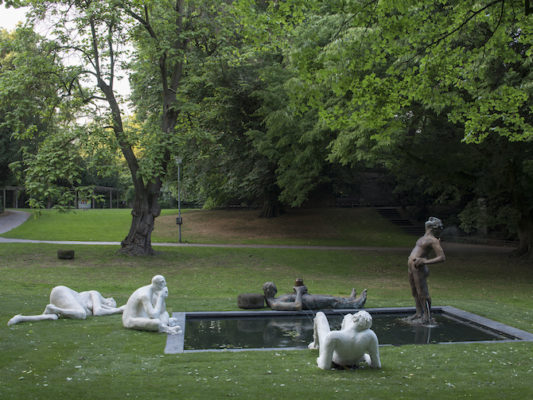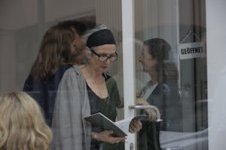Search
To search for an exact match, type the word or phrase you want in quotation marks.
A*DESK has been offering since 2002 contents about criticism and contemporary art. A*DESK has become consolidated thanks to all those who have believed in the project, all those who have followed us, debating, participating and collaborating. Many people have collaborated with A*DESK, and continue to do so. Their efforts, knowledge and belief in the project are what make it grow internationally. At A*DESK we have also generated work for over one hundred professionals in culture, from small collaborations with reviews and classes, to more prolonged and intense collaborations.
At A*DESK we believe in the need for free and universal access to culture and knowledge. We want to carry on being independent, remaining open to more ideas and opinions. If you believe in A*DESK, we need your backing to be able to continue. You can now participate in the project by supporting it. You can choose how much you want to contribute to the project.
You can decide how much you want to bring to the project.

Documenta 14 is on display in two antipodean urban settings of Europe: in the Greek capital Athens and the peripheral German town of Kassel. Skulptur Projekte Münster converts the capital of Westphalia every ten years into a huge exhibition venue. On its fifth edition, the art project in the wealthy city of Münster cooperates with Marl, that several decades ago was a flourishing industrial town. The contrasting two-city-cooperation is, no doubt, a common feature of these two German art events in this unique art year when the Venice Biennale, Documenta and Skulptur Projekte Münster take place simultaneously.
Many critics have been comparing Documenta with Skulptur Projekte Münster, which, in fact, is like comparing apples with oranges. In Athens and Kassel Adam Szymczik (*1974) has diligently placed on show a “market of opportunities” with world art by 150 artists of all genres – which definitely offers some chance of discovering unknown artists. The choice of venues, parcours including a catalogue design – with no pagination, no alphabetical chronology of artist portraits – reveal Szymczik’s strong urge to be innovative, to present a totally different Documenta from any preceding one.
It is in sharp contrast with Münster, that focuses on 35 projects, on one genre that is art in the public space and, most of all, is organized by an experienced curator. Kasper König (*1943 Münster) initiated this format in 1977 and has handled since then quite a few influential exhibitions like “Westart” (1981) or “Von hier aus” (1984). And “the format”, as is argued in the catalogue, “amounts to a disclosure of Münster’s state of mind’; it provides glimpses behind its façades, examining the life it leads and its self-absorption”. Most important is König’s vision of sustainability. Each edition inscribes itself into the existing social and urban situation consisting of sculptures purchased since 1977, which are still on display all over the city centre. Why Marl has been chosen to cooperate with Münster was at first surprising, considering the genesis of both cities, which have gone in quite different directions in the years of the ’German Economic Miracle’ after the Second World War.
The medieval centre of Münster was destroyed severely in the war, however, soon beautifully re-constructed. Today, the University City is prosperous and quite popular among students, especially as it is the most popular Bicycle City in Germany. The city of Marl – on the border between Westphalia and the once highly industrialized Ruhr Area- was founded by the National-Socialists and then destroyed in the war, prospering in the Fifties due to its flourishing chemical and coalmining industry. Therefore, it was able to commission the two Dutch architects Johannes van den Broek and Jacob Berend Bakema to build a utopian urban setting in the modernistic style of Brutalism – including a town hall and shopping mall. A considerable acquisition of sculptures began in order to install them into the functionally oriented public space. The museum of sculpture, called Glaskasten, next to the town hall, has been playing an important role in the cultural development of Marl. Today, 70 sculptures are installed throughout the city with its squares, its lake and park. Art in public space has become part of the community, which unfortunately today is one of the most impoverished in North Rhine-Westphalia.
“The Hot Wire” is the politically connoted title of the art cooperation between Münster and Marl, which can only be understood after having made the grand tour through the Skulptur Projekte Münster. It has been – this should be pointed out here -curated by Kasper König together with Britta Peters (*1967) and Marianne Wagner (*1978), which might explain why half of the participating artists are female – something you don’t find in either Venice or Kassel and Athens.
The Münster tour could begin next to the gothic cathedral, called “Münster”, preferably on a bike. Around the corner, in the Museum für Kunst und Kultur, the German artist Gregor Schneider (*1969, Rheydt) has installed a flat for his fictive character N. Schmidt, which consists of a confusing architecture of duplications. A little further on, Gerard Byrne (*1969 Dublin) has selected a room in the municipal library for his mise en scène of a poetical and highly satirical radio programme with news and weather reports. And whoever wants to learn about the history of Münster and its relevance for European philosophy should visit the on-going action in the historical town hall, by Alexandra Pirici (*1982 Bucharest) about territorial conflicts and situations. The theatre of Münster is the venue of Ashok Sukumaron (*1974 Hokkaido) and Shaina Anand (*1975 Bombay), two members of the constantly regrouped interdisciplinary study CAMP, and their symbolic network installed in a very heterogeneous architectural context.
The fundamental idea of Skulptur Projekte Münster is dealt with in quite a humorous way by the North-American Nicole Eisenmann (*1965 Verdun). Her voluminous sculptures made of plaster and bronze are assembled in a very relaxed manner around a little pond in the green belt of Münster. Political and at the same time intriguingly poetical is the film installation by Mika Rottenberg (*1976 Buenos Aires), in a closed-down shop of Asian products. Her film wittily refers to migratory and highly political issues by combining documentary and surprisingly aesthetic views of the wall between the USA and Mexico, with fictional scenes in which people are creeping through a tunnel that serves as a trading connection between two Chinese restaurants on both sides of the wall. A stop at Lake Aa is absolutely a must in Skulptur Projekte, because here is where you will find many of the works from preceding editions of Skulptur Projekte Münster – like the “Giant Pool Balls” by Claes Oldenburg (1977) or Jorge Pardo’s “Pier” (1997).

“The Hot Wire” – the cooperative project between Münster and Marl, between the curatorial team in Münster and the director of Glaskasten, Georg Elben, is first symbolized by some pieces realized in the form of twins in both locations. Thus Lara Favaretto (*1973 Turin) shows her hollowed-out granite boulders in Münster as well as in Marl. Thomas Schütte (*1954 Oldenburg), who in Münster is also present with his “Nuclear Temple”, has created a counterpart to his “Kirschensäule” (Cherry Pillar, 1987) in Münster for Marl, which is a pillar with watermelons. Sany / Samuel Nyholm (*1973, Lund) has tagged Marl and Münster with his humorous “Tings”. The installation “Angst” (1989) by the German Ludger Gerdes (1954-2008) on the façade of the Rathaus in Marl in turn – and this is the second strategy of “the Hot Line” – has been swapped to the façade of a shopping centre in Münster.
The Glaskasten hosts an exhibition of realized and non-realized art work in Marl and from the different editions of the Skulptur Projekte Münster. Fascinating, in this context, are the miniatures of “Roman de Münster” by Dominique Gonzales-Foerster (*1965 Strasbourg), exhibited in the last edition of the event. The Marl parcours continues around the city lake and finally through the park with further sculptures from the Marl collection. Following the chalk line in the grass drawn by the Belgian Joëlle Tuerlinckx (*1958 Brussels), you arrive at a former school in a Brutalist building with video works by 14 young artists with all kinds of narratives about the cultural and architectural history of Marl. In conclusion, we could say that “the Hot Wire” between Marl and Skulptur Projekte Münster is enlightening in both cities and in many ways. It undoubtedly deserves national as well as international awareness and hopefully some beneficial city marketing, especially for Marl.

Uta M. Reindl, * 1951 in Cologne. Free-lance critic, curator, translator based in Cologne. Regular publications in magazines/dailies, mainly for Kunstforum International; catalogues; edition of two books – focussing also on contemporary art in Spain; curating joint-ventures of artists with students (1996 – 2010), art in public spaces (2001), in galleries (1999/2012); organizing the regional critic platform „Kritisches Rheinland“ since 1996.
"A desk is a dangerous place from which to watch the world" (John Le Carré)